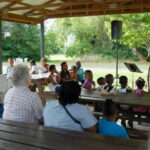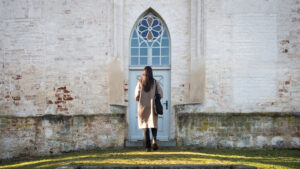In the late 1990s, a friend asked pastor Curtis Cook if he’d ever want to plant a church in Boston.
Back then, the town that had been built by Puritans was only around 2 percent evangelical. Half the residents were Catholic, though in just a few years, The Boston Globe would break the news that the Catholic Church had been covering up sexual abuse for decades, and attendance and donations would begin to slide. At Harvard University, which had been founded to train Puritan clergy, 80 percent of students in 2000 were in favor of legalizing same-sex marriage.
It was a tough field, but that wasn’t why Cook told his friend no.

“I just didn’t think I was a church planter,” he said.
A year or two later, Cook moved to Boston to do campus ministry. He loved it but soon experienced what his friend was seeing—there weren’t many good churches nearby that he could send his students to.
One train stop out from Harvard was “a little Southern Baptist Convention (SBC) church that had been planted back in the ’60s,” Cook said. “It had dwindled down to about 15 people.”
He tried to help out, preaching on Sundays and helping them think through their future: Should they shut down? No, they wanted to keep going. Should they revitalize? That was hard to do with no existing leadership.
“Things were so desperate,” he said. “They were open to anything. We tried for nine months to find a planter and cast a vision. We brought a few people in, but no one was interested, and no one was buying the vision.”
Slowly, Cook began to talk himself into the job. In 2003, without even having been an elder anywhere, and in a denomination that hardly existed in the Northeast, Cook jumped in.

Within a year, Hope Fellowship Church had 40 people. Within four, they had around 200. Today, Hope sees about 300 each week.
That’s a lot of growth in a state now tied for least religious in the country. But it’s even more remarkable when you know that Hope regularly sends people and finances to new churches, including three plants of their own.
“They changed from inward-looking to outward-looking very quickly,” said Dane Helsing, a Hope associate pastor turned church planter. “Curtis has welcomed anybody who is interested in planting—he will never say no to a coffee meeting with anybody. He’s met hundreds of people over the last 20-plus years who want to talk about planting.”
That’s one reason Cook can say he sees more healthy churches in a variety of denominations and networks across Boston and New England now than at any time in the last 25 years.
“I’m from the Bible Belt, and I love it there,” Cook said. “But I can recommend more churches with confidence in the greater Boston area than in several Southern cities. These churches are trying to have some form of membership, faithful leadership, and expository preaching. It really is an encouraging time.”
Backing into Boston
Cook grew up in a charismatic, faith-healing church on the extreme end of Pentecostal. When he got to Oklahoma State University, he “was really immature,” he said.
He fell in with the Baptist campus ministry, which mentored him, gave him a job, and directed him toward Southwestern Baptist Theological Seminary.
“I was becoming more aware of what was going on elsewhere in the country and world,” Cook said. “I thought if I left my role in Oklahoma, there were plenty of people to do that. But there were other parts of the country with far fewer gospel workers. So I began to think about going someplace else.”
One unreached place was the northeast United States. The 2000 U.S. Census showed the population was somewhere between 2 to 4 percent evangelical, depending on how narrowly you defined “evangelical.”
In fact, when Mark and Connie Stump moved to Boston the year Cook replanted Hope, Connie “didn’t expect that [they’d] even find a Southern Baptist church.”
Mark started working about a month before Connie and the kids arrived. The first week he was there, he visited Hope.
“He called me right after church and said, ‘I found a great church with nice people, but there’s only 18 people there and they have no children’s ministry,’” Connie remembers. “We had a 1-year-old and 3-year-old and had just found out I was pregnant. So he said, ‘We can’t go there, but it was super nice.’”
Bumpy Beginning
Years later, someone asked Cook what he’d do over if he could. “Try to find a way to serve on the church staff of a healthy church before I tried to plant one,” he said.
Because in the beginning, he had no idea what to do. The leading voices in evangelicalism were Rick Warren and Andy Stanley, but Cook didn’t have a megachurch in the suburbs. So he found sermons on cassette from a guy named Tim Keller who’d planted a church in New York about a decade earlier.
“His ministry was super influential, even though I never met him,” Cook said. “I mooched ideas and attended a few conferences.”

Cook also ran across 9Marks materials and went to a weekender conference at Capitol Hill Baptist Church.
“I started to say things out loud that I thought we wanted to do, but I wasn’t sure how,” he said. I’m going to preach expositionally. We’re going to have meaningful membership. We’re going to have a plurality of elders. We’re going to plant churches. We’re going to invest in unreached people groups.
Those sentences sound ridiculous when you’re saying them to a dozen people—three of them your wife and kids. How was Hope going to plant when she wasn’t even the size of a self-respecting church plant herself? How was she going to have more than one small group?
Doggedly, Cook started working on the Sunday service. He knew from Keller that he should preach as if nonbelievers were there, so he’d say things like “If you’re here today and not a believer . . .”
“There were only 17 people there,” he said. “They’re looking around like, ‘Who is he talking about? We think we’re all Christians.’”
Any visitors who came didn’t usually come back. Hope was just too small.
“It was slow and bumpy in the beginning, and we made a lot of mistakes,” Cook said. “But none of them was big enough to kill the church, fortunately.”
Fools for Christ
Mark and Connie tried several churches in the area. One was unfriendly, one felt too impersonal, and one was too far to drive.
“We just kept coming back to Hope,” Connie said. The teaching was good, and the people were friendly. At first hesitant to commit because they weren’t sure where they’d buy a house, the Stumps eventually flipped that around and bought a house because it was closer to the church.
“The church was very much like our family,” Connie said. Members ate lunch together, celebrated birthdays together, played games together. And together they worked like crazy to let their neighborhood know they were there.
For example, before settling on the name Hope Fellowship, Cook went down to the grocery store with four names and spent two hours asking people which one they liked the best. (Hope won by a landslide.)

Next, “one of the guys thought we should try giving away Christmas trees,” Connie said. “Because Mark and I are not very creative, we were like, That will never work.”
But somebody found a Christmas tree farmer who’d donate 75 trees. And the church members papered the neighborhood with door hangers: If you want a free Christmas tree, call us. People did, and Hope members ended up delivering them in a nor’easter.
That didn’t slow them down. They bought granola bars, added cards with the church’s information, and handed them out at the bus stops and subway stations. They did the same with packs of gum, coffee, and water bottles.
Again, Mark and Connie were skeptical. That’s not going to work, Mark remembers thinking. That might be the dumbest idea I’ve ever heard.
Until he talked to a newcomer after the service and heard he was there because of a granola bar. “It worked phenomenally,” he says now.
“Because everybody thinks you’re selling something,” Connie said. “So when all they get is a bottle of water and not a conversation, they’re refreshed.” Some of them keep the card, and later, “when something in their life is upside down, and they haven’t been able to stop thinking about the weird experience they had with the church people, they think, Maybe I should go try that.”

During tax season, Cook bought stamps and passed them out just outside the post office. The post office employees questioned him, but he wasn’t doing anything illegal, so they let him keep going.
Hope also bought ad space on the train, using it to post a C. S. Lewis quote and the church information. “The Lord really used that to bring people in,” Mark said.
“I think of Paul saying he’s willing to be a fool for Christ,” Connie said. “Curtis is also willing to be a fool for Christ. He’ll try anything.”
“Still, the most fruitful way that we’ve reached people is through our people being on mission and sharing with and inviting friends, classmates, coworkers,” Cook said. “God is kind. There were always enough positive glimmers of someone curious about the faith or someone eager to grow as a disciple to keep me going.”
Planting
Hope didn’t have to find a place to worship; they were in a building that had been paid off by previous church members. But it wasn’t huge—it only seats 220—and as Hope grew, her leaders began to look around for larger spaces.
“We looked on numerous occasions,” Mark said. “We even put down an offer on one building, but we got outbid.”
Cook added a second service; for a while, he even tried a third.

“Because we didn’t have room or find a building to buy, that propelled us into church planting earlier than we would have,” Connie said.
Today, that seems like a natural decision. But back then, planting in New England was hard, especially for a denomination rooted in the South.
“I moved to New England in November 1993,” wrote SBC pastor Terry Dorsett. “Going to associational meetings was sometimes depressing because it seemed like the pastors all had celebrated ‘low attendance’ day instead of ‘high attendance’ days. At one point I was the chairman of the mission committee in one of our New England associations and for three years in a row every single one of our mission churches had failed to survive.”
Looking back, Cook can identify a few challenges church planters were facing.
“My amateur observations were first, that there were basically very few, if any, healthy local churches a planter could come into and be sent out of,” Cook said. “Now almost nobody plants without coming to a local church in the area, doing a residency or internship, and having time to adjust. And then they’re sent out, which is absolutely appropriate and helpful.”
Second, back then the SBC’s policy was to help with funding for two years, which was great if you were planting in, say, Oklahoma. At the end of two years, you’d probably have enough members to be self-sustaining.
But in the Northeast, two years might net you only 35 people. That’s a good start, Cook said, but not many supporters recognized that it would take much longer to establish a self-funding church in New England. He asked his supporting churches to spread his two years of support over four years.
For Hope, that was enough. By then, they’d constituted and were ready to try a second campus, Tim Keller–style.
“We rented space across the river in Brookline and had a Sunday evening service there,” Cook said. “I preached, the band played, it was Hope Fellowship Coolidge Corner. But we didn’t have a fully developed plan of the end game. Does it stay part of Hope? Do we spin it off?”
When Cook’s friend Bland Mason came to do a church planting residency at Hope, he took over the plant and named it City on a Hill. Then he went on a church planting tear, starting seven churches in eight years.

Hope kept at it too. They added two more daughter churches and sent funding and people to a handful more.
“Rather than trying to plant a church of 3,000, we thought if we could plant 10 churches that were 300 people each, we’d be able to reach more people that way,” Cook said. Those small churches would also be “more contextual and more reproducible, because not many guys have the skill set it takes to pastor a church of 3,000. But we can find guys who can pastor a church of 40 to 300 people.”
Cook always keeps that before his people. At quarterly members’ meetings, Hope members hear from mission partners and church planters. In the weekly pastoral prayers, Cook prays for other churches and unreached people. During budget meetings, Hope’s leaders give more than 20 percent of her income away to missions.
“They continue to welcome people in—they always have summer interns and church planting residents,” Helsing said. “It’s the ongoing open-handed generosity of welcoming in anybody who wants to learn or experience life in a missional church or who wants to talk about church planting.”
It seems like he’s always running into people who know each other because they both knew Cook. “I see the missional ripple effect of Hope,” he said.
Churches in New England
In 1962, eight churches formed a small network in New England. Today, the Baptist Convention of New England has 388 churches. More than a third have been planted since 2010. And that’s not counting the growing number of gospel-preaching churches in other networks and denominations.

“We are grateful for all the ways God is working here—we are seeing a slow, steady and very significant awakening through the ministries of hundreds of small and faithful churches,” said Paul Buckley, who planted King of Grace Church 45 minutes north of Hope in 2002. Like Hope, King of Grace has also planted three churches.
“Today, many towns and cities of New England have one or more gospel-loving churches,” Buckley wrote for The Gospel Coalition. “Most sections of Boston are within walking distance of a church that proclaims Christ and models missional, gospel community.”
Last year, when the SBC reported membership losses across the U.S., the notable exception was New England. Instead, from 2017 to 2022, membership in New England rose from about 27,500 to more than 30,000.
The data “almost makes us a bit more resolute,” said Boston-area church planter Aaron Cavin, after sharing it at a local training for church planters. Twenty-five miles to the northeast, Gordon-Conwell Theological Seminary announced it was adding a church planting concentration.
Massachusetts’s evangelical Protestant population is still tiny—just 3.65 percent in 2020. But that’s up from 2.37 percent in 2000 and 1.4 percent in 1980.
“I feel really privileged to bear witness to what God is doing through Hope all these years,” Connie said. “I could not in a million years have guessed I’d get to be near and see God work so beautifully.”
Try Before You Buy: FREE Sample of TGC’s New Advent Devotional
 Choosing the right Advent daily devotional can be tough when there are so many options. We want to make it easier for you by giving you a FREE sample of TGC’s brand-new Advent devotional today.
Choosing the right Advent daily devotional can be tough when there are so many options. We want to make it easier for you by giving you a FREE sample of TGC’s brand-new Advent devotional today.
Unto Us is designed to help you ponder the many meanings of this season. Written by TGC staff, it offers daily Scripture readings, reflections, and questions to ponder. We’ll send you a free sample of the first five days so you can try it out before purchasing it for yourself or your church.

































